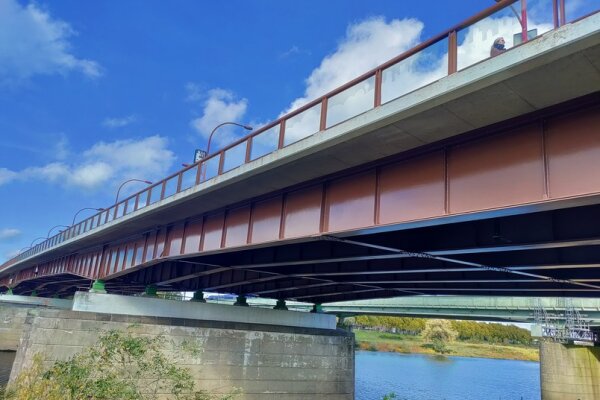12.05.2023

An essential aspect in the design and dimensioning of structures is structural fire protection. As part of a new DFG project, Mehmed Numanović, a doctoral student at the Chair of Steel, Lightweight and Composite Construction, is investigating the load-bearing capacity and fire behaviour of steel-concrete beam structures in order to optimise a standard for the fire protection of buildings.
When a building burns, the heat causes components to fail. This poses great dangers. For example, three railway bridges had to be demolished after a fuel-laden lorry caused a major fire on the A40 in Mülheim. In order to give people enough time to get to safety, standards for the construction of bridges, high-rise buildings and other structures have been set that state how long a structure must withstand the heat. Mehmed Numanović is now working on developing this standard further.
How does concrete interact with steel in the event of fire?
As part of the DFG project "Shear buckling of steel-concrete composite plate girders under fire exposure", Mehmed Numanović is looking into the question of how concrete influences the heat resistance of a structure. In construction, sheet steel girders are often used as structural elements in combination with a concrete slab, which are connected to the girder via shear studs and act as a steel-concrete composite cross-section. With steel alone, it is already known that stiffness and strength decrease above 400 degrees Celsius. Now the project team is testing how different steel-concrete beam constructions behave under load and heat in a large test rig in the KIBKON hall with an electric modular oven that can reach temperatures of up to 1,200 degrees Celsius. Components are used that are also used in reality in bridge and building construction. Specimens with different properties are used, such as the thickness of the steel sheets, the number and spacing of the transverse stiffeners or even the head bolts with the concrete slab.
The test results are then transferred to a numerical model that calculates the load-bearing capacity of such beam constructions. In the future, engineers will be able to configure bridges, high-rise buildings and other structures in accordance with standards using a tool based on this model.
An essential aspect in the design and dimensioning of structures is structural fire protection. As part of a new DFG project, Mehmed Numanović, a doctoral student at the Chair of Steel, Lightweight and Composite Construction, is investigating the load-bearing capacity and fire behaviour of steel-concrete beam structures in order to optimise a standard for the fire protection of buildings.
When a building burns, the heat causes components to fail. This poses great dangers. For example, three railway bridges had to be demolished after a fuel-laden lorry caused a major fire on the A40 in Mülheim. In order to give people enough time to get to safety, standards for the construction of bridges, high-rise buildings and other structures have been set that state how long a structure must withstand the heat. Mehmed Numanović is now working on developing this standard further.
How does concrete interact with steel in the event of fire?
As part of the DFG project "Shear buckling of steel-concrete composite plate girders under fire exposure", Mehmed Numanović is looking into the question of how concrete influences the heat resistance of a structure. In construction, sheet steel girders are often used as structural elements in combination with a concrete slab, which are connected to the girder via shear studs and act as a steel-concrete composite cross-section. With steel alone, it is already known that stiffness and strength decrease above 400 degrees Celsius. Now the project team is testing how different steel-concrete beam constructions behave under load and heat in a large test rig in the KIBKON hall with an electric modular oven that can reach temperatures of up to 1,200 degrees Celsius. Components are used that are also used in reality in bridge and building construction. Specimens with different properties are used, such as the thickness of the steel sheets, the number and spacing of the transverse stiffeners or even the head bolts with the concrete slab.
The test results are then transferred to a numerical model that calculates the load-bearing capacity of such beam constructions. In the future, engineers will be able to configure bridges, high-rise buildings and other structures in accordance with standards using a tool based on this model.
You can find more information about the testing and images in the detailed article on the RUB Newsportal and in the next issue of the science magazine Rubin. Subscribe now for free here.
Photo: © Mehmed Numanović